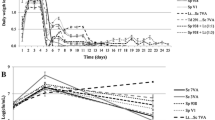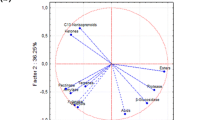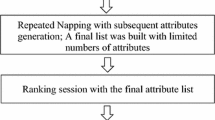Abstract
The production of nonvolatile and volatile compounds by different commercial non-Saccharomyces yeast strains in Riesling grape musts was monitored during fermentation, and the related changes in wine quality were noted. Sequential fermentations of Saccharomyces cerevisiae with Pichia kluyveri, Lachancea thermotolerans, or Metschnikowia pulcherrima were compared to a single fermentation using S. cerevisiae alone. The results from all developed analyses showed significant differences in several parameters including population kinetics, nonvolatile and volatile compounds, and sensorial parameters.



Similar content being viewed by others
References
Jolly NP, Varela C, Pretorius IS (2014) Not your ordinary yeast: non-Saccharomyces yeasts in wine production uncovered. FEMS Yeast Res 14:215–237
Sadoudi M, Tourdot-Marechal R, Rousseaux S, Steyer D, Gallardo-Chacon JJ, Ballester J, Vichi S, Guerin-Schneider R, Caixach J, Alexandre H (2012) Yeast- yeast interactions revealed by aromatic profile analysis of Sauvignon Blanc wine fermented by single or co-culture of non-Saccharomyces and Saccharomyces yeasts. Food Microbiol 32:243–253
Jolly NP, Augustyn OPH, Pretorius IS (2003) The effect of non-Saccharomyces yeasts on fermentation and wine quality. S Afr J Enol Vitic 24:55–62
Soden A, Francis I, Oakey H, Henschke P (2000) Effects of co-fermentation with Candida stellata and Saccharomyces cerevisiae on the aroma and composition of Chardonnay wine. Aust J Grape Wine Res 6:21–30
Azzolini M, Fedrizzi B, Tosi E, Finato F, Vagnoli P, Scrinzi C, Zapparoli G (2012) Effects of Torulaspora delbrueckii and Saccharomyces cerevisiae mixed cultures on fermentation and aroma of Amarone wine. Eur Food Res Technol 235:303–313
King A, Dickson JR (2000) Biotransformation of monoterpene alcohols by Saccharomyces cerevisiae, Torulaspora delbrueckii and Kluyveromuces lactis. Yeast 16:499–506
Rodríguez ME, Lopes CA, Barbagelata RJ, Barda NB, Caballero AC (2010) Influence of Candida pulcherrima Patagonian strain on alcoholic fermentation behaviour and wine aroma. Int J Food Microbiol 138:19–25
Parapouli M, Hatziloukas E, Drainas C, Perisynakis A (2010) The effect of Debina grapevine indigenous yeast strains of Metschnikowia and Saccharomyces on wine flavour. J Ind Mircobiol Biotechnol 37:85–93
Clemente-Jiménez JF, Mingorance-Cazorla L, Martínez-Rodríguez S, Las Heras-Vázquez FJ, Rodríguez-Vico F (2004) Molecular characterization and oenological properties of wine yeast isolated during spontaneous fermentation of six varieties of grape must. Food Microbiol 21:149–155
Andorra I, Berradre M, Rozes N, Mas A, Guillamon JM, Esteve-Zarzoso B (2012) Effect of pure and mixed cultures of the main wine yeast species on grape must fermentations. Eur Food Res Technol 231:215–224
Rementeria A, Rodríguez JA, Cadaval A, Amenabar R, Muguruza JR, Hernando FL, Sevilla MJ (2003) Yeast associated with spontaneous fermentations of white wines from the “Txakoli de Bizkaia” region (Basque Country, North Spain). Int J Food Microbiol 86:201–207
Viana F, Gil JV, Valles S, Manzanares P (2009) Increasing the levels of 2-phenyl ethyl acetate in wine through the use of a mixed culture of Hanseniaspora osmophila and Saccharomyces cerevisiae. Int J Food Microbiol 135:68–74
Moreira N, De Pinho PG, Santos C, Vasconcelos I (2010) Volatile sulphur compounds composition of monovarietal white wines. Food Chem 123:1198–1203
Izquierdo-Cañas PM, García-Romero E, Heras JM, Fernández-González M (2014) Influence of sequential inoculation of Wickerhamomyces anomalus and Saccharomyces cerevisiae in the quality of red wines. Eur Food Sci Technol 239:279–286
Benito S, Palomero F, Morata A, Calderon F, Palmero D, Suarez-Lepe JA (2013) Physiological features of Schizosaccharomyces pombe of interest in making of white wines. Eur Food Res Technol 236:29–36
Peinado RA, Moreno JJ, Maestre O (2007) Removing gluconic acid by using different treatments with a Schizosaccharomyces pombe mutant: effect on fermentation byproducts. Food Chem 104:457–465
Gobbi M, Comitini F, Domizio P, Romani C, Lencioni L, Mannazzu I, Ciani M (2013) Lachancea thermotolerans and Saccharomyces cerevisiae in simultaneous and sequential co-fermentation: a strategy to enhance acidity and improve the overall quality of wine. Food Microbiol 33:271–281
Takush DG, Osborne JP (2012) Impact of yeast on the aroma and flavour of Oregon Pinot Noir wine. Aust J Grape Wine Res 18:131–137
Erten H, Tanguler H (2010) Influence of Williopsis saturnus yeasts in combination with Saccharomyces cerevisiae on wine fermentation. Lett Appl Microbiol 50:474–479
Tanguler H (2012) Evaluation of Williopsis saturnus inoculums level on fermentation and flavour compounds of white wines made from Emir (Vitis vinifera L.) grown in Anatolia. Food Biotechnol 26:351–368
Toro ME, Vazquez F (2002) Fermentation behaviour of controlled mixed and sequential cultures of Candida cantarellii and Saccharomyces cerevisiae wine yeasts. World J Microbiol Biotechnol 18:347–354
Morata A, Benito S, Loira I, Palomero F, González MC, Suarez-Lepe JA (2012) Formation of pyranoanthocyanins by Schizosaccharomyces pombe during the fermentation of red must. Int J Food Microbiol 159:47–53
Benito S, Palomero P, Morata A, Calderón F, Suárez-Lépe JA (2012) New applications for Schizosaccharomyces pombe in the alcoholic fermentation of red wines. Int J Food Sci Technol 47:2101–2108
Benito S, Palomero P, Gálvez L, Morata A, Calderón F, Palmero D, Suárez-Lepe JA (2014) Quality and composition of red wine fermented with Schizosaccharomyces pombe as Sole Fermentative Yeast, and in mixed and sequential fermentations with Saccharomyces cerevisiae. Food Technol Biotechnol 52:376–382
Viana F, Belloch C, Valles S, Manzanares P (2011) Monitoring a mixed starter of Hanseniaspora vineae-Saccharomyces cerevisiae in natural must: impact on 2-phenylethyl acetate production. Int J Food Microbiol 151:235–240
Belda I, Navascués E, Marquina D, Santos A, Calderon F, Benito S (2014) Dynamic analysis of physiological properties of Torulaspora delbrueckii in wine fermentations and its incidence on wine quality. Appl Microbiol Biotechnol 99:1911–1922
Egli CN, Edinger WD, Mitrakul C, Henick-Kling T (1998) Dynamics of indigenous and inoculated yeast populations and their effect on the sensory character of Riesling and Chardonnay wines. J Appl Microbiol 85:779–789
Esteve-Zarzoso B, Manzanares P, Ramón D, Querol A (1998) The role of non-Saccharomyces yeasts in industrial winemaking. Int Microbiol 1:143–148
Fleet GH (2003) Yeast interactions and wine flavour. Int J Food Microbiol 86:11–22
Fleet GH (2008) Wine yeasts for the future. FEMS Yeast Res 8:979–995
Fleet GH, Heard GM (1993) Yeast-growth during fermentation. In: Fleet GH (ed) Wine microbiology and biotechnology. Harwood Academic Publishers, Chur, pp 27–54
Gil JV, Mateo JJ, Jimenez M, Pastor A, Huerta T (1996) Aroma compounds in wines as influenced by apiculate yeasts. J Food Sci 61:1247–1250
Henick-Kling T, Edinger W, Daniel P, Monk P (1998) Selective effects of sulfur dioxide and yeast starter culture addition on indigenous yeast populations and sensory characteristics of wine. J Appl Microbiol 84:865–876
Lambrechts MG, Pretorius IS (2000) Yeast and its importance to wine aroma: a review. S Afr J Enol Vitic 21:97–129
Romano P, Fiore C, Paraggio M, Caruso M, Capece A (2003) Function of yeast species and strains in wine flavour. Int J Food Microbiol 86:169–180
Viana F, Gil JV, Genovés S, Vallés S, Manzanares P (2008) Rational selection of non-Saccharomyces wine yeasts for mixed starters based on ester formation and enological traits. Food Microbiol 25:778–785
Rojas V, Gil JV, Piñaga F, Manzanares P (2001) Studies on acetate ester production by non-Saccharomyces wine yeasts. Int J Food Microbiol 70:283–289
Ciani M, Comitini F, Mannazzu I, Domizio P (2010) Controlled mixed culture fermentation: a new perspective on the use of non-Saccharomyces yeasts in winemaking. FEMS Yeast Res 10:123–333
Contreras A, Hidalgo C, Henschke PA, Chambers PJ, Curtin C, Varela C (2014) Evaluation of non-Saccharomyces yeasts for the reduction of alcohol content in wine. Appl Environ Microbiol 80:1670–1678
Benito S, Palomero P, Calderón F, Palmero D, Suárez-Lepe JA (2014) Schizosaccharomyces. In: Batt CA, Tortorello ML (eds) Encyclopedia of food microbiology, vol 3. Elsevier, Amsterdam, pp 365–370
Herraiz T, Reglero G, Herraiz M, Martin-Alvarez PJ, Cabezudo MD (1990) The influence of the yeast and type of culture on the volatile composition of wines fermented without sulfur dioxide. Am J Enol Vitic 41:313–318
Zironi R, Romano P, Suzzi G, Battistutta F, Comi G (1993) Volatile metabolites produced in wine by mixed and sequential cultures of Hanseniaspora guilliermondii or Kloeckera apiculata and Saccharomyces cerevisiae. Biotechnol Lett 15:235–238
González-Royo E, Pascual O, Kontoudakis N, Esteruelas M, Esteve-Zarzoso B, Mas A, Canals JM, Zamora F (2015) Oenological consequences of sequential inoculation with non-Saccharomyces yeasts (Torulaspora delbrueckii or Metschnikowia pulcherrima) and Saccharomyces cerevisiae in base wine for sparkling wine production. Eur Food Res Technol. doi:10.1007/s0021701424048
Oro L, Ciani M, Comitini F (2014) Antimicrobial activity of Metschnikowia pulcherrima on wine yeasts. J Appl Microbiol 116:1209–1217
Di Maio S, Genna G, Gandolfo V, Amore G, Ciaccio M, Oliva D (2012) Presence of Candida zemplinina in Sicilian musts and selection of a strain for wine mixed fermentations. S Afr J Enol Vitic 33:80–87
Domizio P, Romani C, Lencioni L, Comitini F, Gobbi M, Mannazzu I, Ciani M (2011) Outlining a future for non-Saccharomyces yeasts: selection of putative spoilage wine strains to be used in association with Saccharomyces cerevisiae for grape juice fermentation. Int J Food Microbiol 147:170–180
Domizio P, Romani C, Comitini F, Gobbi M, Lencioni L, Mannazzu I, Ciani M (2011) Potential spoilage non-Saccharomyces yeasts in mixed cultures with Saccharomyces cerevisiae. Ann Microbiol 61:137–144
Sampaio TL, Kennedy A, Vasconcelos MC (2007) Use of microscale fermentations in grape and wine research. Am J Enol Vitic 58:534–539
Kurtzman CP, Fell JW (1998) Methods for the isolation, maintenance and identification of yeasts. In: Kurtzman CP, Fell JW (eds) The yeast. A taxonomic study. Elsevier, Amsterdam, pp 79–80
Vaughnan-Martini A, Martini A (1999) Determination of ethanol production. In: Kurtzman CP, Fell JW (eds) The yeast. A taxonomic study. Elsevier, Amsterdam, p 107
Official methods for the analysis of musts and wines of the internantional organisation of vine and wine (2014) OIV, Paris. http://www.oiv.int/oiv/info/enmethodesinternationalesvin. Accesses 1 March 2015
Morris EO, Eddy AA (1957) Method for the measurement of wild yeast infection in pitching yeast. J Inst Brew 63:34–35
Rapp A, Yavas I, Hastrich H (1994) Einfache und schnelle Anreicherung (“Kaltronmethode”) von Aromastoffen des Weines und deren quantitative Bestimmung mittels Kapillargaschromatographie. Deut Lebensm-Rundsch 90:171–174
Günata Y, Bayonove C, Baumes R, Cordonnier R (1985) The aroma of grapes. Extraction and determination of free and glycosidically bound fractions of some grape aroma components. J Chromatogr A 331:83–90
Kotseridis Y, Baumes RL, Skouroumounis GK (1999) Quantitative determination of free and hydrolytically liberated β-damascenone in red grapes and wines using a stable isotope dilution assay. J Chromatogr A 849(1):245–254
Schüttler A (2012) Influencing factors on aromatic typicality of wines from Vitis vinifera L. cv. Riesling sensory, chemical and viticultural insights (Doctoral thesis). Université de Bordeaux and Justus Liebig University Giessen
Schüttler A, Friedel M, Jung R, Rauhut D, Darriet P (2015) Characterizing aromatic typicality of Riesling wines: merging volatile compositional and sensory aspects. Food Res Int 69:26–37
Albergaria H, Francisco D, Gori K, Arneborg N, Gírio F (2010) Saccharomyces cerevisiae CCMI 885 secretes peptides that inhibit the growth of some non-Saccharomyces wine-related strains. Appl Microbiol Biotechnol 86:965–972
Kapsopoulou K, Mourtzini A, Anthoulas M, Nerantzis E (2007) Biological acidification during grape must fermentation using mixed cultures of Kluyveromyces thermotolerans and Saccharomyces cerevisiae. World J Microbiol Biotechnol 23:735–739
Comitini F, Gobbi M, Domizio P, Romani C, Lencioni L, Mannazzu I, Ciani M (2011) Selected non-Saccharomyces wine yeast in controlled multistarter fermentations with Saccharomyces cerevisiae. Food Microbiol 28:873–882
Jolly NP, Augustyn OPH, Pretorius IS (2006) The role and use of non-Saccharomyces yeasts in wine production. S Afr J Enol Vitic 27:15–39
Su J, Wang T, Wang Y, Li YY, Li H (2014) The use of lactic acid-producing, malic acid-producing, or malic acid-degrading yeast strains for acidity adjustment in the wine industry. Appl Microbiol Biotechnol 98:2395–2413
Benito A, Palomero F, Calderon F, Benito S (2015) Combine use of selected Schizosaccharomyces pombe and Lachancea thermotolerans yeast strains as an alternative to the traditional malolactic fermentation in red wine production. Molecules 20:9510–9523
Ciani M, Beco L, Comitini F (2006) Fermentation behavior and metabolic interactions of multistarter wine yeast fermentations. Int J Food Microbiol 108:239–245
Renault P, Miot-Sertier C, Marullo P, Hernández-Orte P, Lagarrigue L, Lonvaud-Funel A, Bely M (2009) Genetic characterization and phenotypic variability in Torulaspora delbrueckii species: potential applications in the wine industry. Int J Food Microbiol 134:201–210
Benito S, Palomero P, Calderón F, Palmero D, Suárez-Lépe JA (2014) Selection of appropriate Schizosaccharomyces strains for winemaking. Food Microbiol 42:218–224
Jackowetz J, Dierschke S, Mira de Orduna R (2011) Multifactorial analysis of acetaldehyde kinetics during alcoholic fermentation by Saccharomyces cerevisiae. Food Res Int 44:310–316
Zoecklein B, Fugelsang K, Gump B, Nury F (1995) Wine analysis and production. Kluwer Academic/Aspen Publishers, New York
Merico A, Sulo P, Piskur J, Compagno C (2007) Fermentative lifestyle in yeasts belonging to the Saccharomyces complex. FEBS J 274:976–989
Bely M, Stoeckle P, Masneuf-Pomarède I, Dubourdieu D (2008) Impact of mixed Torulaspora delbrueckii–Saccharomyces cerevisiae culture on high-sugar fermentation. Int J Food Microbiol 122:312–320
Kutyna DR, Varela C, Henschke PA, Chambers PJ, Stanley GA (2010) Microbiological approaches to lowering ethanol concentration in wine. Trends Food Sci Technol 21:293–302
Zohre DE, Erten H (2002) The influence of Kloeckera apiculata and Candida pulcherrima yeasts on wine fermentation. Process Biochem 38:319–324
Morales P, Rojas V, Quirós M, Gonzalez R (2015) The impact of oxygen on the final alcohol content of wine fermented by a mixed starter culture. Appl Microbiol Biotechnol. doi:10.1007/s00253-014-6321-3
Rapp and Mandery, Rapp A, Mandery H (1986) Wine aroma. Experentia 42:873–884
Romano P, Suzzi G (1993) Higher alcohol and acetoin production by Zygosaccharomyces wine yeasts. J Appl Bacteriol 75:541–545
Bartowsky E, Pretorius I (2009) Microbial formation and modification of flavor and off- flavor compounds in wine. In: König H, Unden G, Fröhlich J (eds) Biology of microorganisms on grapes, in must and in wine. Springer, Berlin, pp 209–232
Moreno J, Peinado R (2012) Enological chemistry. Academic Press Elsevier, Amsterdam, p 39
Lehtonen P (1996) Determination of amines and amino acids in wine: a review. Am J Enol Vitic 47(2):127–133
Alcaide-Hidalgo JM, Moreno-Arribas MV, Martín-Álvarez PJ, Polo MC (2007) Influence of malolactic fermentation, postfermentative treatments and ageing with lees on nitrogen compounds of red wines. Food Chem 103:572–581
Acknowledgments
The authors are very grateful for the help received from Biosystems S.A. for the donation of the enzyme kits used in this work and from the accredited laboratory Estación Enológica de Haro for performing the amino acid analysis.
Author information
Authors and Affiliations
Corresponding author
Ethics declarations
Conflict of interest
None.
Compliance with ethics requirements
This article does not contain any studies with human or animal subjects.
Rights and permissions
About this article
Cite this article
Benito, S., Hofmann, T., Laier, M. et al. Effect on quality and composition of Riesling wines fermented by sequential inoculation with non-Saccharomyces and Saccharomyces cerevisiae . Eur Food Res Technol 241, 707–717 (2015). https://doi.org/10.1007/s00217-015-2497-8
Received:
Accepted:
Published:
Issue Date:
DOI: https://doi.org/10.1007/s00217-015-2497-8




